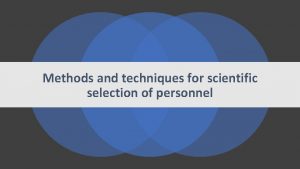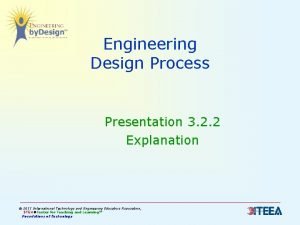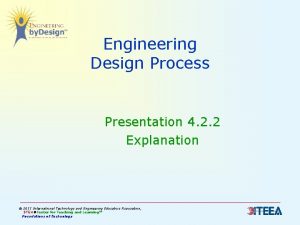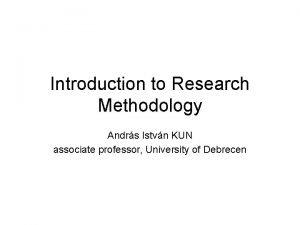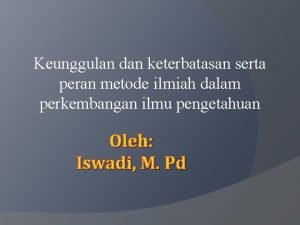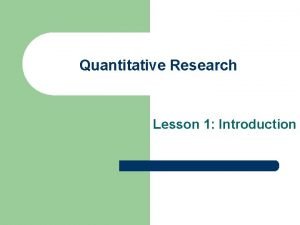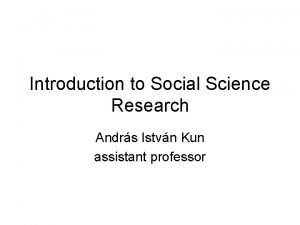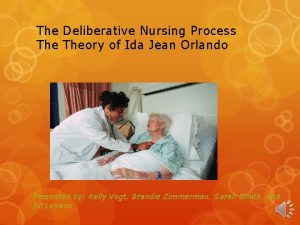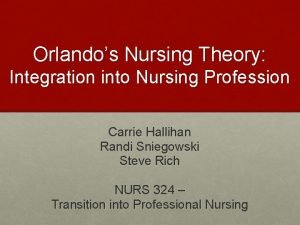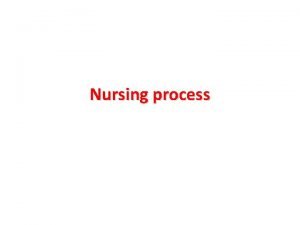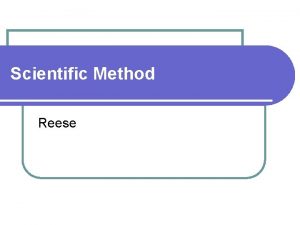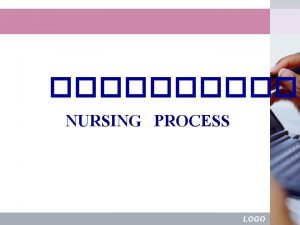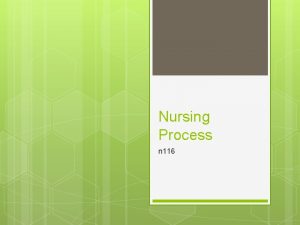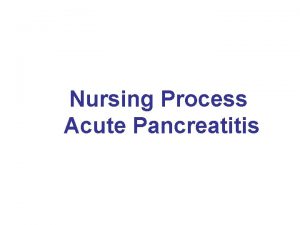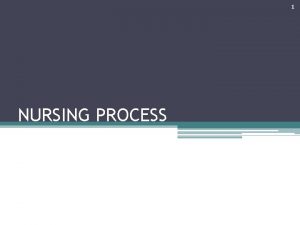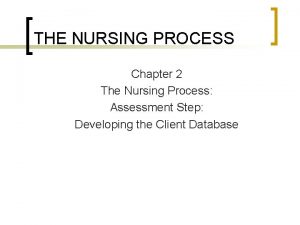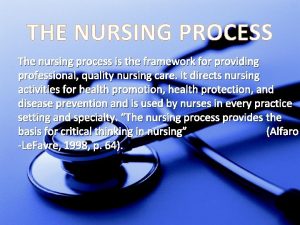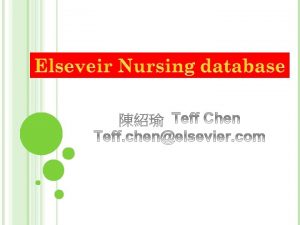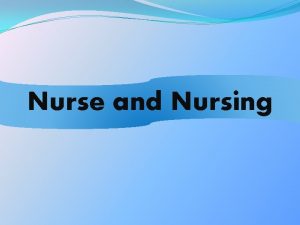Nursing research Nursing research is a scientific process
























- Slides: 24

Nursing research • Nursing research is a “scientific process that validates and refines knowledge and generates new knowledge that directly and indirectly influences nursing practice

• Evidence-based practice • is using the best evidence available to guide clinical decision making. • The identification of the knowledge base for nursing practice contributes to achieving client outcomes and making nursing practice • credible. The emphasis on quality care based on evidence and research is an increasing focus in all areas of health care.

• Research Knowledge gained from both nursing research and practice is necessary to support the predictable outcomes of nursing care. • Research used in nursing comes from nursing as other disciplines such as psychology, education, sociology, biology, and anthropology. Nursing research explores the many pathways through which scientific and practical knowledge regarding nursing care is established

Research Process • The person conducting the research is called researcher, investigator, or scientist. When a researcher poses a problem or answers a question using the scientific approach, itis called a study, an investigation, or a research project. The people who are being studied are called subjects or study participants

• Concept the process of developing and refining concepts is referred to as conceptualization. • A construct is an abstraction or mental representation inferred from situations, events, or behaviors. • Constructs are different from concepts in that the constructs are deliberately invented by researchers for a specific scientific purpose

• These concepts or constructs are ideas that formulate a theory (asset of concepts and propositions that provide an orderly way to view phenomena). • In a theory, concepts (or constructs) are knitted together into an orderly system to explain the way in which our world and the people in it function • Nurse researchers can use one of two broad approaches to gather and analyze scientific information

• Quantitative research: the systematic collection of numerical information, often under conditions of considerable control, and the analysis of the information using statistical procedures • Qualitative research: The systematic collection and analysis of more subjective narrative materials, using procedures in which there tends to be a minimum of researcher-imposed control

• The scientific method requires an exact, orderly, and objective approach of acquiring knowledge. Controlled methods are used to study problems and test • The hypothesis (statement of an asserted relationship between two or more variables • A variable is anything that may differ from the norm. The two types of variables are independent and dependent

• The independent variable • (criterion variable) is that variable that is believed to cause or influence • The dependent variable • which is the outcome variable of interest and is the variable that is hypothesized to variable

• For example, if the question reads to what extent does age C predict recovery from surgical anesthesia relative to when h preoperative instructions were first given • the independent a variable is age and the dependent variable Is r recovery from surgical anesthesia relative to when preoperative instructions were first given.

• Value is the variation of the variable. • The values of the independent a variable are actual ages of surgical clients, and the c values of the dependent variable are when instructions were first given. • There are multiple ways in which nurses establish the sources and the knowledge about nursing, human responses, diagnoses, and treatments describe how nursing has historically acquired knowledge

• Traditions: basing practice on customs and past trends Authority: crediting another person as the source of information • Borrowing: using knowledge from other disciplines to guide nursing practice • Trial and error: using unknown outcomes in a situation of uncertainty • Intuition: being guided by a feeling or sense that cannot be logically explained

• Reasoning: processing and organizing ideas in order to reach conclusions • Research: validating and refining existing knowledge and generating new knowledge • Empirical: using research to explain, describe, and predict • Ethical: extending knowledge of valuing, clarifying, and advocating • Personal: encountering and focusing on self and others • Esthetics: interpreting, engaging, and envisioning clues to knowledge

• The research process is based on sequential, Interrelated steps • the researcher has developed the conceptual framework, the research literature is reviewed to provide a foundation on which to base new knowledge. • In selecting a research design, the researcher determines the methods to be used to address the research question and test the hypothesis, the specific population to be studied, and how the data will be collected

• Knowledge in nursing is developed and used most effectively through the combination of nursing theory, research, and practice • Following data collection, the researcher subjects the data to analysis in an orderly fashion so that patterns and relationships can be discerned • Research and Evidence-Based Practice terms of its applicability

• Research and Evidence-Based Practice terms of its applicability to other settings or groups • *whereas quantitative information is usually analyzed through statistical procedures. • If the data support the research hypothesis, the findings are reported in a straightforward fashion • if the results fail to support the hypothesis, the researcher must explain the possible reasons for synthesizing

• The research findings can be communicated in various forms as dissertations and journal articles. Usually, research reports discuss how the findings can be incorporated into the practice of nursing Rights • During the research design phase of the process, the researcher must determine how to safeguard the rights of the research participants. • An important role of the nurse researcher is that of advocate for the clients’ rights during the process • the human rights that require protection during research.

• Obtaining informed consent requires that the researcher provide full disclosure (communication of complete information to potential research subjects theory in regarding the nature of the study, • the subject’s right to refuse participation, and the likely risks and benefits that would be incurred) • The nature, seriousness, and likelihood of risks (physical, psychological, social, and legal) are explained to the participants.

• The researcher must also identify what precautions will be taken to minimize the risks. • Protection of subjects requires that the potential benefits outweigh potential risks nurse • . Have an obligation to collaborate in the research, • provided the researcher has followed proper protocols

• . The researcher must obtain permission from the agency to use its facility as part of the research setting. • Staff nurses who are expected to participate in the research process must have an adequate understanding of the nature of the study. • the staff nurse has the right to refuse to participate in the study

• TYPES OF RESEARCH DESIGN • Historical: • Systematic investigation of a past event using relevant sources to describe or explain the event • Exploratory: • Preliminary investigation designed to develop or refine hypotheses or to test the data collection methods

• Evaluative: • Systematic investigation of how well a program, practice, or policy is working • Descriptive: • Investigations that have as their main objective the accurate portrayal of the

• 5 - Experimental: Research studies in which the investigator controls (manipulates) the Independent variable and randomly assigns subjects to different conditions • Nurse's use scientific and ―other ways of knowing "to measure the effectiveness of nursing interventions. Name and describe three ―other ways of knowing‖ that you use in your personal life to solve problems. • What are the advantages and disadvantages of each method you use? • How can ―other ways of knowing be used by nurses to measure the client‘s situation.

• Quasi-experimental: • Studies that deviate from the methods of the experimental component in that subjects cannot be randomly assigned to treatment conditions even though • the researcher • manipulates the independent variable and exercises certain controls to enhance the internal validity of the results
 Information gathered during an experiment
Information gathered during an experiment How is a scientific law different from a scientific theory?
How is a scientific law different from a scientific theory? Psychiatric nursing process
Psychiatric nursing process Nursing process in psychiatric nursing
Nursing process in psychiatric nursing Measuring in science process skills
Measuring in science process skills Scientific
Scientific Six ps of planning
Six ps of planning Scientific method vs engineering design process
Scientific method vs engineering design process Scientific method vs engineering design process
Scientific method vs engineering design process National center for scientific research demokritos
National center for scientific research demokritos Define scientific research
Define scientific research Hamid d. ismail
Hamid d. ismail Keunggulan dan keterbatasan metode ilmiah
Keunggulan dan keterbatasan metode ilmiah Lesson 1 quantitative research design
Lesson 1 quantitative research design What is scientific research
What is scientific research Scientific misconduct in research
Scientific misconduct in research Functional nursing definition
Functional nursing definition Care plan on ocd
Care plan on ocd Nursing care plan for eye surgery
Nursing care plan for eye surgery Planning in nursing process
Planning in nursing process Nursing process
Nursing process 3 part nursing diagnosis examples
3 part nursing diagnosis examples Nursing process theory
Nursing process theory Orlando nursing theory
Orlando nursing theory Nursing diagnosis of lung cancer
Nursing diagnosis of lung cancer





